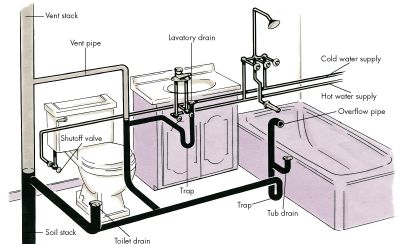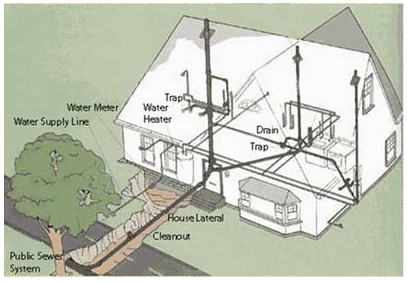Exploring Your Home's Plumbing System Anatomy
Exploring Your Home's Plumbing System Anatomy
Blog Article
We've unearthed this article involving Exploring Your Homes Plumbing Anatomy down the page on the internet and decided it made perfect sense to discuss it with you here.

Comprehending exactly how your home's plumbing system functions is important for every single house owner. From delivering tidy water for drinking, cooking, and showering to safely eliminating wastewater, a well-maintained plumbing system is critical for your family's health and wellness and convenience. In this thorough guide, we'll check out the detailed network that makes up your home's pipes and deal suggestions on upkeep, upgrades, and handling typical issues.
Introduction
Your home's pipes system is more than simply a network of pipes; it's a complicated system that ensures you have access to tidy water and efficient wastewater elimination. Knowing its parts and how they interact can assist you prevent expensive repair services and ensure everything runs smoothly.
Fundamental Components of a Pipes System
Pipes and Tubing
At the heart of your plumbing system are the pipelines and tubing that lug water throughout your home. These can be made of numerous materials such as copper, PVC, or PEX, each with its benefits in terms of longevity and cost-effectiveness.
Fixtures: Sinks, Toilets, Showers, and so on.
Fixtures like sinks, toilets, showers, and bath tubs are where water is utilized in your house. Comprehending exactly how these fixtures link to the pipes system helps in identifying issues and planning upgrades.
Shutoffs and Shut-off Factors
Valves manage the circulation of water in your pipes system. Shut-off valves are critical during emergencies or when you require to make fixings, allowing you to separate parts of the system without interrupting water circulation to the entire house.
Water System System
Main Water Line
The main water line attaches your home to the municipal water system or a private well. It's where water enters your home and is dispersed to numerous fixtures.
Water Meter and Stress Regulator
The water meter procedures your water usage, while a stress regulatory authority guarantees that water moves at a safe stress throughout your home's plumbing system, avoiding damage to pipelines and fixtures.
Cold Water vs. Warm water Lines
Understanding the difference in between cold water lines, which supply water straight from the major, and hot water lines, which bring heated water from the hot water heater, assists in repairing and preparing for upgrades.
Water drainage System
Drain Pipes Piping and Traps
Drain pipes carry wastewater away from sinks, showers, and toilets to the drain or sewage-disposal tank. Traps avoid sewer gases from entering your home and likewise catch particles that could trigger blockages.
Air flow Pipelines
Air flow pipes enable air right into the drain system, protecting against suction that can reduce water drainage and trigger catches to vacant. Appropriate air flow is necessary for keeping the honesty of your pipes system.
Relevance of Correct Drainage
Guaranteeing proper drainage avoids backups and water damages. Frequently cleaning drains and maintaining catches can stop expensive repair work and extend the life of your pipes system.
Water Furnace
Sorts Of Water Heaters
Water heaters can be tankless or conventional tank-style. Tankless heaters warmth water as needed, while containers keep warmed water for prompt usage.
Upgrading Your Plumbing System
Reasons for Updating
Updating to water-efficient components or replacing old pipelines can boost water high quality, decrease water bills, and boost the value of your home.
Modern Pipes Technologies and Their Advantages
Check out modern technologies like wise leak detectors, water-saving toilets, and energy-efficient hot water heater that can save cash and decrease ecological effect.
Price Considerations and ROI
Determine the ahead of time expenses versus long-lasting savings when considering plumbing upgrades. Several upgrades pay for themselves through lowered utility bills and fewer repairs.
Just How Water Heaters Link to the Plumbing System
Recognizing how hot water heater link to both the cold water supply and warm water circulation lines helps in diagnosing concerns like insufficient hot water or leakages.
Maintenance Tips for Water Heaters
Consistently flushing your hot water heater to eliminate sediment, checking the temperature level setups, and examining for leaks can expand its life expectancy and improve energy performance.
Typical Plumbing Issues
Leakages and Their Causes
Leakages can happen due to maturing pipes, loosened installations, or high water stress. Resolving leakages immediately avoids water damages and mold growth.
Obstructions and Clogs
Blockages in drains pipes and commodes are frequently caused by purging non-flushable items or an accumulation of oil and hair. Using drainpipe displays and bearing in mind what goes down your drains can protect against obstructions.
Signs of Plumbing Issues to Look For
Low tide pressure, sluggish drains, foul odors, or uncommonly high water bills are indications of prospective pipes troubles that need to be addressed quickly.
Plumbing Maintenance Tips
Regular Examinations and Checks
Schedule annual pipes examinations to capture issues early. Look for indicators of leakages, deterioration, or mineral build-up in faucets and showerheads.
DIY Maintenance Tasks
Simple tasks like cleansing faucet aerators, checking for bathroom leaks utilizing dye tablet computers, or shielding exposed pipes in cool climates can stop significant pipes concerns.
When to Call a Professional Plumbing
Know when a pipes problem calls for expert knowledge. Trying complex repair services without proper knowledge can lead to even more damage and greater repair work prices.
Tips for Decreasing Water Usage
Basic habits like taking care of leaks immediately, taking much shorter showers, and running full tons of laundry and meals can preserve water and lower your energy costs.
Eco-Friendly Plumbing Options
Consider sustainable pipes materials like bamboo for floor covering, which is durable and environment-friendly, or recycled glass for countertops.
Emergency situation Preparedness
Steps to Take During a Plumbing Emergency situation
Know where your shut-off shutoffs are located and just how to shut off the water in case of a ruptured pipeline or major leakage.
Importance of Having Emergency Get In Touches With Convenient
Keep call info for regional plumbings or emergency situation services readily offered for quick action during a plumbing situation.
Environmental Effect and Preservation
Water-Saving Fixtures and Home Appliances
Installing low-flow faucets, showerheads, and bathrooms can substantially lower water usage without sacrificing performance.
Do It Yourself Emergency Fixes (When Applicable).
Temporary solutions like making use of duct tape to patch a dripping pipeline or placing a pail under a leaking faucet can minimize damages until an expert plumber arrives.
Verdict.
Understanding the makeup of your home's plumbing system empowers you to maintain it efficiently, conserving time and money on repair work. By following routine upkeep routines and remaining educated regarding modern plumbing modern technologies, you can ensure your plumbing system operates effectively for many years to find.
Exploring Your Homes Plumbing Anatomy
Water Supply System
Main Water Line: This is where water enters your home from the municipal supply or a private well. Water Meter: Typically located near where the main water line enters the property, it measures the amount of water used. Shutoff Valve: It s crucial to know where this is in case of emergencies. It allows you to turn off the water supply to the entire house. Pipes and Fittings: These distribute water throughout your home. Materials can include copper, PVC, or PEX. Drain-Waste-Vent (DWV) System
Drains: Located in sinks, showers, and tubs, these carry wastewater away. Traps: U-shaped pipes under sinks that hold standing water, blocking sewer gases from entering the home. Vents: Pipes that lead from the DWV system to the outside, preventing vacuum formation and allowing gases to escape. Sewer Line: Carries all wastewater from the home to the municipal sewer system or a septic tank. Fixtures and Appliances
Sinks, Toilets, and Showers Dishwashers and Washing Machines Water Heaters Maintenance Tips
Regularly check for leaks in exposed pipes and around fixtures. Inspect the water heater annually for signs of wear. Clean drains and traps to prevent clogs and odors. Know how to shut off water to individual fixtures. When to Call a Professional
Major leaks or burst pipes Installation of new pipes or fixtures Septic tank issues Remodeling projects that involve plumbing changes Conclusion
Understanding the anatomy of your home's plumbing is key to maintaining a functional and efficient system. Regular checks and knowing when to call in the experts can save you time, money, and stress.
https://www.mavyn.com/blog/exploring-your-homes-plumbing-anatomy

We had been brought to that report on Plumbing Installation 101: All You Need to Know through an acquaintance on a different web address. Do you know about anybody else who is inquisitive about The Inner Workings of Your Home's Plumbing? Why not share it. Thank-you for going through it.
Schedule Now! Report this page